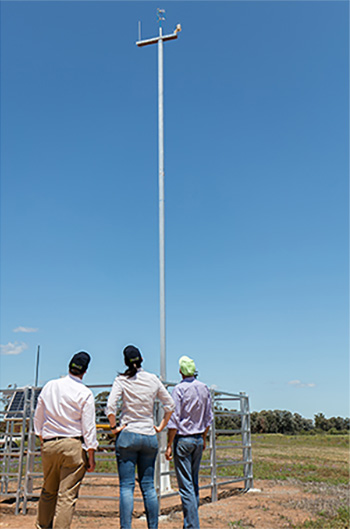Grain and cotton growers have been embracing the active weather and networked data (WAND) stations popping up across New South Wales and Queensland, with local grower groups calling for spray applicators to make use of the reliable system to avoid spray drift implications.
WAND is a $5.5 million investment being rolled out by GRDC, the Cotton Research and Development Corporation (CRDC) and Goanna Ag to develop a spray drift hazardous weather warning system across Queensland and NSW.
Under the investment, a network of weather stations have been installed across growing regions to provide real-time weather data that identifies and measures the presence of hazardous temperature inversions. This is a free network that all growers and spray applicators can access via their smartphone.
 WAND is a $5.5 million investment being rolled out by GRDC, CRDC and Goanna Ag to develop a spray drift hazardous weather warning system across Queensland and NSW. It's free for growers to use. Credit: Melanie Jenson
WAND is a $5.5 million investment being rolled out by GRDC, CRDC and Goanna Ag to develop a spray drift hazardous weather warning system across Queensland and NSW. It's free for growers to use. Credit: Melanie Jenson
Mungindi Cropping Group Project Officer, Jo Weier says unfortunately for the Mungindi and Gwydir regions, spray drift has been a significant issue, impacting both winter and summer crops' profitability.
"Crop damage caused by spray drift has been a longstanding issue of ours," she says.
"This year in particular, we saw a lot of damage to wheat and sorghum from Roundup during the winter and spring months and more recently, we've had a lot of cotton damaged from 2,4-D.
"At our last cropping group meeting, growers were obviously concerned about the level of spray drift damage being reported in the area, so we decided to actively promote the tools available to help applicators identify inversion conditions and not to spray herbicide when they are occurring."
Ms Weier says the WAND inversion towers have been a valuable addition to the regions, with many growers and spray applicators making use of the technology.
But, for the technology to be truly effective and minimise the number of crops being impacted by spray drift, Ms Weier says everyone in the region spraying herbicide had to utilise it.
"Information from WAND isn't a licence to spray just another tool to aid in making decisions around spraying. It's a great tool, but we need everyone spraying chemical to use the system," she says.
"We'll see a real difference if everyone is using the data to identify inversions and actively choosing not to spray when damage can occur.
"It's innovative technology that growers can easily use, so we're trying to make sure everyone's aware they have access to it."
Both the Mungindi Cropping Group and the local Moree grower group, SOS Gwydir, committed funds to rolling out an active communications campaign on WAND and how growers can use it to identify hazardous inversion conditions.
"We have been working to get the message out across industry that the towers are functioning, informative and available to help monitor the presence of inversions during peak spraying times," Ms Weier says.
"We've funded radio advertisements, a local mailbox drop with information on how to access the system and we've put resources and money behind an active social media campaign.
"We know that the majority of growers across our region are always trying to do the right thing when they're spraying, so making use of this technology should make it easier for them to be confident they're acting responsibly. We're just doing what we can to give the system maximum exposure, so the uptake continues."
GRDC chemical regulation manager Gordon Cumming says before the WAND system, it wasn't possible for spray applicators to accurately measure the presence of hazardous inversion conditions.
"By having this information at hand, growers and spray operators will be well-placed to avoid hazardous inversions and may? find that there are more hours open to spraying at night than first thought," he says.
Mr Cumming says it was fantastic to see grower groups, like the Mungindi Cropping Group and SOS Gwydir, actively working to mitigate spray drift and promote the WAND system throughout their regions.
"It's a credit to the groups for taking the initiative to ensure all growers have access to information to help them make more informed spraying decisions that could prevent serious crop damage," he says.
"Industry uptake of the WAND system is what will drive its success and we support the growers and groups working to help us spread the message."
GRDC has recently released a video explaining the WAND system in more detail, including how growers can access the data.






